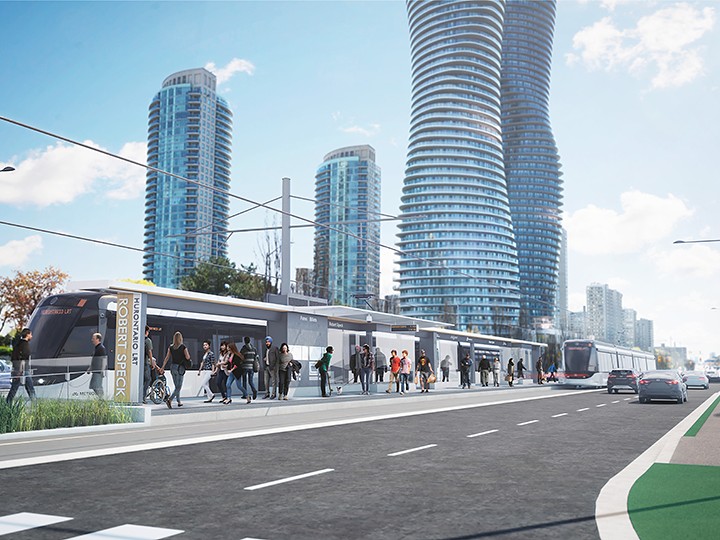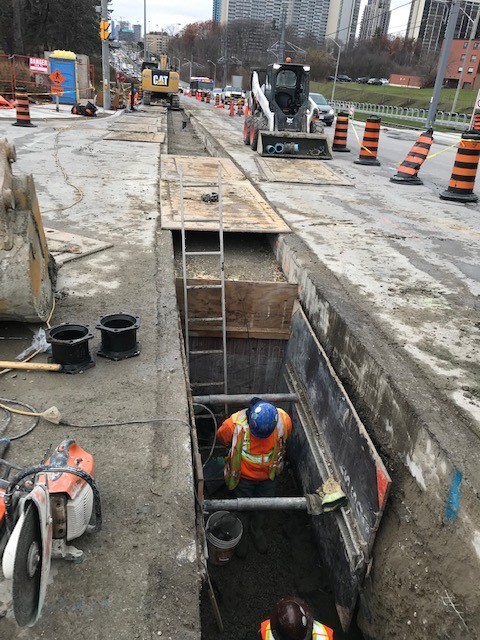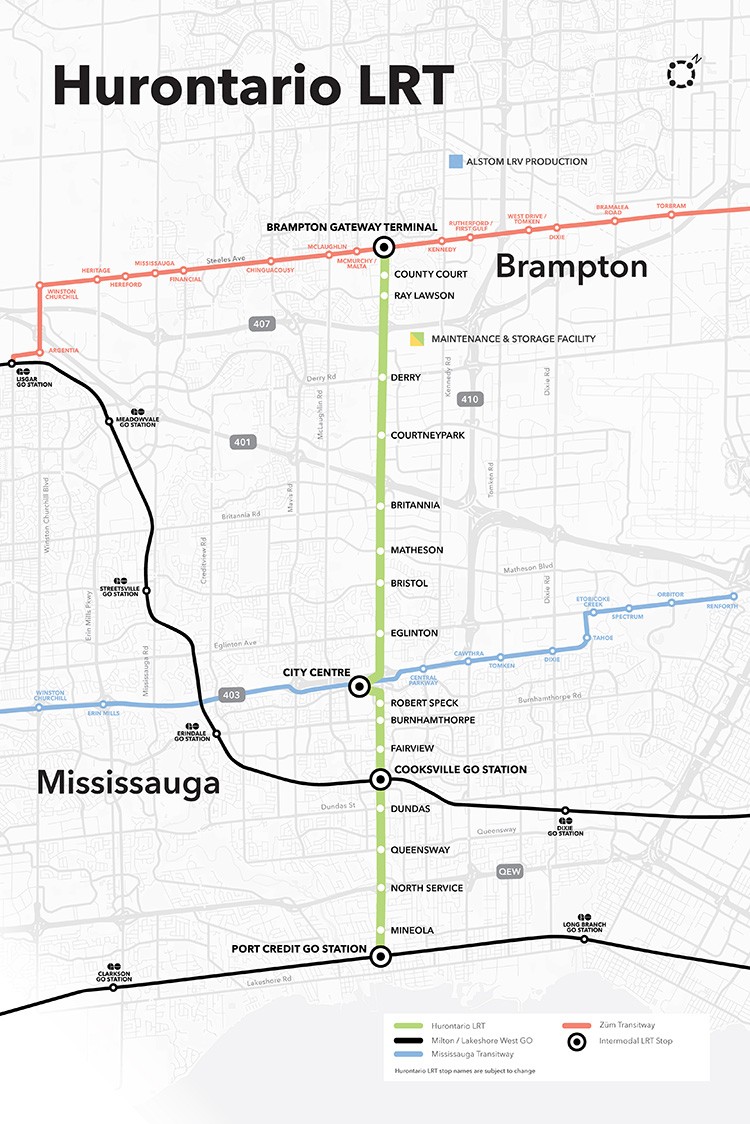
Two years behind schedule, can the Hurontario LRT avoid further pitfalls that have tripped up other major transit projects?
September 14, 2019 was a joyous day in Ottawa. The city’s first light rail transit system opened after years of disruptive construction.
The unveiling of the 12.5-kilometre LRT allowed residents their first opportunity to use the highly anticipated transit system that tax dollars had been poured into for years.
It was only a matter of days before the first of many delays occurred for the now notoriously panned project.
The first snafu was thought to be a freak accident, a small glitch in the train system — a common problem that could easily be fixed.
But things grew exponentially worse.
Doors would jam and shut down the operation; computer problems mounted; track switches would stop working; burst pipes; trains unexpectedly lost power; and, infamously, the entire network could not function during Ottawa’s first snowstorm of 2020.
It was one thing after another, causing massive headaches for residents relying on the new commuter rail system, which experienced many of its worst malfunctions during its busiest periods — morning and evening rush hour.
By the end of November 2021, a public inquiry was triggered – an attempt to figure out how things could have gone so wrong, so fast.
The disastrous implementation is a lesson for transit builders the world over. When it comes to complex high-order projects, it’s safe to assume that not everything will go as planned. Mobilinx, the consortium behind Mississauga’s Hurontario LRT project, assures The Pointer construction is on track for its 2024 completion date. But unexpected delays could be waiting around the corner.
Toronto’s Eglinton Crosstown LRT is another example of a high-order transit project plagued by delays. The Crosstown has been under construction for the last decade. The 25 stations stretch across 19 kilometres of dense urban neighbourhoods, and is now expected to be completed in late 2022. This is the most recently delayed date, which Metrolinx says is a result of COVID lockdowns (delaying a previously planned September 2021 opening date).
Shovels hit dirt on the project in 2011, and over the past 10 years it has been complicated by various situations, one being the construction of the Yonge-Eglinton station, existing city infrastructure and the COVID-19 pandemic.
Similar to Ottawa’s LRT, the Crosstown has the potential to be a transformative project for the City of Toronto, allowing multiple easy connections to TTC Subway and GO stations, marking a vast improvement on Toronto’s infamously disconnected transit system.

Construction on the Eglinton Crosstown has been ongoing for more than 10 years.
(Image from Metrolinx)
The Region of Waterloo’s ION LRT system also had a turbulent journey spanning almost two decades. Delays in dealings with other railways that would cross the LRT’s path; domes needed for temperature sensitive work; the discovery of one of the Region’s first roads during construction; poor planning causing the rebuilding of platforms — the list goes on. Bombardier, the builder behind the sleek LRT vehicles, fell short of its commitment to deliver a series of these cars on time, delaying the project by two years.
Already, the $4.6 billion Hurontario LRT project that will stretch from Port Credit in the south to Brampton’s Gateway terminal in the north, has had to deal with a significant curveball. Breaking ground in March of 2020, construction continued despite the COVID-19 pandemic spreading across the world at that time.
“When teams become aware of potential delays, mitigation efforts are introduced to reduce the risk of more significant delays,” Duncan Law, head sponsor of the Hurontario LRT, told The Pointer in an email.
Similar to its LRT counterparts in other Ontario cities, the Hurontario LRT has also seen its completion date scaled back from its initial estimate. When the Province (who is funding a large portion of the system) announced Mobilinx will construct the project in 2019, the schedule shifted quietly from a completion date of 2022 to 2024.
Both the Crosstown and Ottawa LRTs stretch through dense urban areas, requiring portions of the light rail to be constructed underground. Ottawa has a 2.5 kilometer tunnel through the downtown, which in the early days of construction (2016) caused a massive sinkhole on one of the city’s busiest streets. Over half of the 19-kilometre Eglinton Crosstown (10 kilometres) will be constructed underground.
By contrast, only the Port Credit GO station, the southern terminus of the Hurontario LRT, will be underground.

The current route of the Hurontario LRT.
(Image from Metrolinx)
This is a significant advantage for the Hurontario LRT as building underground is notoriously more difficult, and more expensive, opening up countless new opportunities for challenges and delays. It does not mean the project is staring down a straight path to completion.
With a multimillion dollar project on a busy roadway in the heart of the city, Law admits there will be challenges. The construction of a bridge over Highway 403 and tunnels under the Queen Elizabeth Way (QEW) and Lakeshore West Go Train tracks to name just two.
This is without taking into consideration the lingering questions in Brampton as councillors in the city continue to squabble over the potential extension of the LRT into the city’s downtown.
Crews are currently excavating for the rail line under the GO tracks just west of Port Credit Station. The goal is to successfully create a throughway for the LRT without disturbing GO Transit.
The route has also not been without controversy. Just before the project was awarded to Mobilinx, Metrolinx cut a downtown loop — approximately two kilometres of track around Square One — reducing the ease of access to the city’s downtown core.
The removal of the loop was protested by members of Mississauga council leading up to the 2019 federal election. Ontario justified the severing of the track because of the rising cost estimates.
Stephen Wickens, an independent transportation researcher in Toronto, believes this loss will be felt by commuters who will need to walk further to stations in the city’s centre.
“Those would have been among the most valuable stations on the line. How well the line connects for pedestrians who get off on Hurontario and have to walk into the densest area of Mississauga is going to matter, and lots of people form their travel habits based on how comfortable the connection is when the weather is bad,” Wickens told The Pointer.
A 2020 report from Ontario’s Auditor General revealed cuts to the trains servicing the line also occurred earlier than the annexing of the loop in late 2019.
In 2018, the number of vehicles set to run along the route dropped from 43 to 28, marking a serious impact on future service delivery and dramatically reducing the convenience. Cutting the trains means wait times at peak hours will increase 50 percent. Riders would previously have waited five minutes between trains during peak times — they now face a seven-and-a-half minute wait.
Renderings above showcase a futuristic idea of what Ottawa (top) and Toronto’s LRT will look like.
(Renderings from Infrastructure Ontario)
The COVID-19 pandemic hit the pause button on a myriad of government efforts as resources were shifted to tackle the unprecedented public health crisis. The Province assures The Pointer that the Hurontario LRT was not one of those projects pushed to the backburner.
“Large transit projects are complex to deliver and unpredictable risks can impact the completion date. To help mitigate these impacts, every aspect of construction has a schedule tied to it and teams review these schedules on a regular basis,” Law said.
At any given time, Law says there are between 150 and 400 people working on the Hurontario LRT day and night.
“Mobilinx is in the final stages of the utility upgrading and replacement,” Law stated in an email. “This work is done first to prepare for the changes in the roadway. Next year, Mobilinx will begin to construct the rail guideway in the middle of the road, with installation of new road surfaces to follow.”
Lanes of traffic have been reduced along Hurontario. Currently workers are digging a tunnel underneath the GO train tracks near Port Credit Station.
(Natasha O’Neill / The Pointer)
According to a December press release, relocation of watermains and storm sewer lines along the LRT’s route in Brampton is now underway.
Hurontario Street is one of the most active roadways in Mississauga, running straight through the city centre. The four lanes allow thousands of vehicles to pass through everyday and act as a key artery connecting to the GTA’s 400-series highways.
Recently, Mobilinx issued a safety reminder to carefully drive through construction zones and to be polite to workers attempting to do their job.
“The transit agency acknowledges construction can be frustrating, but there’s no excuse for verbally or physically harassing anyone simply trying to do their job,” Mobilinx stated in a press release put out after road rage incidents that saw construction workers along the route threatened.
To mitigate impacts felt on commuters and safety of crews, construction will continue throughout the night when necessary. This allows crews to block off sections of the road, shut off utilities as needed, and ensure the project sticks to its quickly approaching deadline.
Temporary bus platforms have been constructed to allow transit operatations to continue along the route while the LRT is being constructed.
(Natasha O’Neill / The Pointer)
The completion of the LRT will mark a large step toward Mississauga’s goal of becoming a transit oriented city. Two bus rapid transit systems on Lakeshore Road and Dundas Street will also contribute to this vision. The completed system needs to offer seamless connections and ease of access in order to compete with the convenience of personal vehicles if the City wants to encourage people to ditch them.
“Creating a pedestrian-focused environment is essential for transit to succeed overall in suburban locations,” Wickens told The Pointer. “Slowing down cars and creating more opportunities for pedestrians to comfortably cross the road can be a hard sell politically when the local electorate is heavily car dependent.”
As construction on the first few phases nears completion, those living closest to the project will notice a few bald spots along the route. To allow for road widening, or sidewalks and multi-use trails to run parallel to the route, a number of trees will be removed.
“The contractor must produce an arborist report and associated tree inventory plans for municipal review,” Joe Perotta, director of the LRT office at the City of Mississauga told The Pointer in an email. “As part of the project agreement, the contractor must follow the City’s municipal standards as they pertain to tree assessments, protection, and replacements where trees will have to be removed.”
New trees will be planted primarily along the LRT route, but some may need to be placed on other properties owned by the City.
Email: [email protected]
Twitter: @taasha__15
COVID-19 is impacting all Canadians. At a time when vital public information is needed by everyone, The Pointer has taken down our paywall on all stories relating to the pandemic and those of public interest to ensure every resident of Brampton and Mississauga has access to the facts. For those who are able, we encourage you to consider a subscription. This will help us report on important public interest issues the community needs to know about now more than ever. You can register for a 30-day free trial HERE. Thereafter, The Pointer will charge $10 a month and you can cancel any time right on the website. Thank you
Submit a correction about this story


